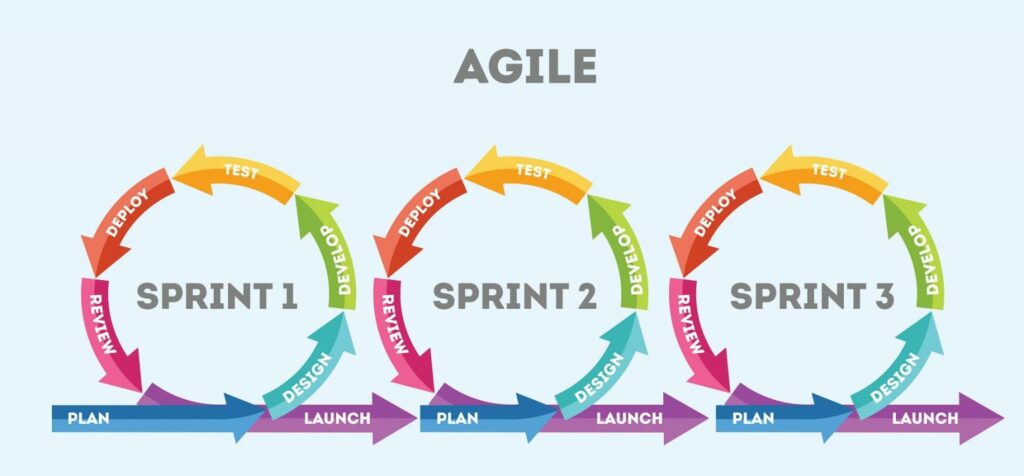Agile project management originated in software development.
Its iterative approach to delivering projects quickly became popular. Programmers could deliver a viable part of a project, get feedback from clients, and adapt as the client’s needs changed.
On the other hand, clients could get their hands on a working piece of software. And provide feedback or request changes before it was too late.
In the marketing world too, Agile project management is fast becoming a staple. 41% of marketers use Agile marketing practices to manage their teams.
In this blog, you’ll learn about Agile project management in marketing. You’ll also learn about the features your marketing project management software needs to support agile methodologies.
What is Agile Marketing?
Agile marketing is the application of Agile project management methods to marketing projects.
It’s a relatively new marketing project management approach that uses principles from Agile software development to meet marketing goals. This includes:
- Small, self-organizing, cross-functional teams
- Deliver a project in frequent iterations called sprints
- And continuously review and update processes based on feedback
Sprints (or iterations) are typically 2 weeks long. However, depending on the project, your team can run shorter or longer sprints.
The origins of Agile PM
The Agile methodology comes from software development in the early 2000s. Technology was moving so fast that the traditional project management approach meant that by the time a project was delivered, it was already out of date.
A group of developers came up with an agile management manifesto to tackle this challenge. It had four core principles:
- Individuals and interactions over processes and tools
- Working software over comprehensive documentation
- Customer collaboration over contract negotiation
- Responding to change instead of following a set plan
Instead of delivering a project to a specific brief set at the beginning, they set value-based goals. They rapidly prototyped and tested software before cycling back into the development phase. This helped them keep the software up to date according to feedback.
This allowed project teams to:
- Learn as they go
- Adapt to unexpected changes
- Deliver a final product that was up-to-date and user-tested
Here’s a quick visual explainer of how it works:
Is Agile the right PM method for you?
As we mentioned above, studies show that over 40% of marketers are already using Agile to manage their marketing projects.
There are several key benefits that marketers see from using Agile methods:
- Faster release timelines
- More productive teams
- More effective prioritization
- More agility to respond to feedback
- Higher overall quality of work
How to know if Agile isn’t the right PM method for you
Agile is not easy to implement for everyone. To make Agile marketing project management work, McKinsey found you need a few key things:
- Clear, measurable goals: for example, grow organic traffic by X%, generate 100 more leads per month, etc.
- Marketing tech to measure progress: the ability to collect and analyze data across systems
- Buyin from marketing leaders: If you’re not all in, it won’t work
- A cross-functional team of talented people
- A clear project communication plan both within the team and with the rest of the stakeholders
Agile marketing project management is also best-suited to marketing projects where iterative work delivers increasing results. For example:
- SEO and content marketing
- Lead generation
- Conversion rate optimization
- Building brand awareness
- Driving your reputation as a thought leader
On the hand, it’s hard to fit marketing projects with rigid time frames into the Agile framework—though not impossible. For example, it’s hard to apply Agile marketing at a single event. However, it’s possible to iteratively improve your marketing processes over multiple events.
How Does Agile PM for Marketing Work?
Kanban vs. Scrum
The two most popular frameworks for implementing Agile project management in marketing are Kanban and Scrum.
What is Kanban?
Kanban is a visual project management tool that uses a board view to capture, organize, and prioritize sprint tasks.

The 6 core practices of Kanban are:
- Visualize sprint workflow
- Limit WIP (Work in Progress)
- Manage the flow
- Make process policies explicit
- Implement feedback loops
- Continually improve
Many marketers prefer Kanban over Scrum because it places less emphasis on team roles and structure, which involves less of a paradigm shift in terms of team and company culture.
What is Scrum?
Scrum, on the other hand, is a full framework for Agile project management. It provides values, guidelines, and roles to help your team focus on continuous improvement and iteration.
To run a Scrum, you first choose a Scrum Master. A Scrum Master is responsible for running the three phases of a Scrum iteration, also called the “Sprint”.
- Sprint planning: The Scrum Master and the team look at the work backlog and choose activities to accomplish during the sprint.
- Daily Scrum standups: Each day of the sprint, the team meets for 15 minutes. The purpose is to check progress and adjust the sprint plan if necessary.
- Sprint retrospective: After each sprint, the team evaluates the work done, moves pending work back to the backlog, and prepares for the next sprint.
Agile team roles
The first thing you need to know is that any Agile team is intended to be a “whole” team.
Look around at your teammates—do you have all the skills and responsibilities in the room to get the project done?
Then you have the beginnings of an Agile team.
Here’s a breakdown of the roles typically found in a small Scrum team.
| Role | Responsibility |
|---|---|
| Team lead or “Scrum Master” | This role encompasses all the soft skills of project management. The Scrum Master is responsible for facilitating the team’s work, getting it the resources it needs to do that work, and protecting it from problems. The technical and scheduling stuff is left up to the team at large. |
| Team member | In agile marketing, this would be a marketer: your social media managers, your content managers, your copywriters. They’re the ones writing and scheduling posts, guiding copy, and creating value. |
| Product owner | The product owner represents the stakeholders and is in charge of the task list. They’re the ones with decision-making power and the pressure to prioritize tasks. |
| Stakeholder | The stakeholder is anyone invested in the project who isn’t directly part of the Scrum team. For example, they could be customers or managers. |
Having roles doesn’t necessarily mean there’s a hierarchy.
In traditional project management, a project lead is at the top of the pyramid with team members working beneath them.
In Agile, it’s a much more collaborative setup, with roles generally operating on the same level.
What’s different about Scrum in a marketing context is that the product owner and team leaders are usually the same people, and the roles of each team member are less rigid.
User Stories
User stories are used to document the client’s requirements in a software project.
Without the guidance of user stories, deliverables may end up not meeting the customers’ expectations..
So how do you leverage user stories in agile marketing?
Marketers work with customers, not users. So instead of user stories, marketers write customer (or audience) stories.
A customer story describes the “why” behind a marketing project or task.
For example, instead of “write a blog post about how to find email addresses”, a customer story reads:
“As a link builder, I would like to learn how to find email addresses, so that I can contact webmasters and send them an email requesting a link back to my website.”
Backlog management and sprint planning
In Agile project management methodology, the “backlog” refers to a list of activities to be done to deliver the entire project.
The marketing project manager adds and prioritizes tasks on the backlog. Here’s an example of project backlog and sprint tasks for a simple web design project.
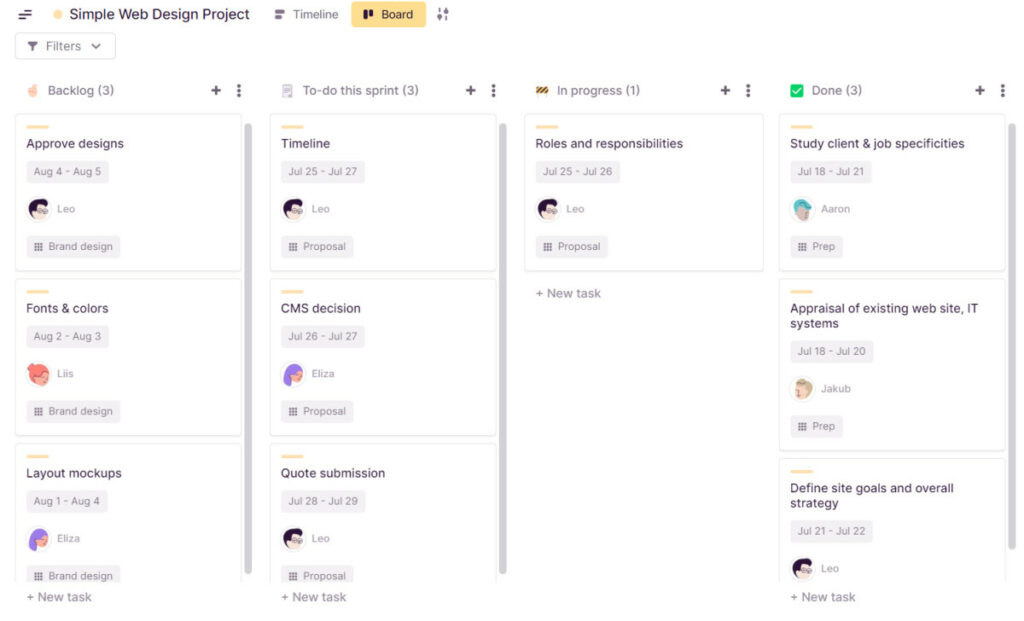
In the sprint planning meeting, the project manager (or the scrum master) and the team choose activities from the backlog to work on during a sprint.
With a Kanban board tool, choosing tasks for a sprint is easy. Just drag and drop a task from the Backlog column to the Sprint column.
Agile estimation techniques
Agile estimation is a team exercise. It’s designed to estimate the effort required by each task to plan the next work cycle.
There are loads of ways to do this, but the simplest (and most fun!) way is with T-shirt sizing.
Yep, you read that correctly. Here’s how it works:
- You sit down with your full Agile team and review a particular user story or task.
- Each member of the team writes down on a piece of paper their estimate for how big of an effort this would be, using T-shirt sizes: XS, S, M, L, or XL.
- Everyone reveals answers at once and discusses the outcome to reach a consensus.
- The project manager uses this consensus to plan and optimize the next sprint.
It’s a simple method if you’re new to Agile marketing management. It’s quick and works in broad strokes, but helps you create reasonably accurate estimates.
Sprint/Scrum meetings
If you’re implementing Agile marketing project management, your meetings will fall into four main categories:
- Sprint planning: Usually an hour a week for the duration of the sprint, where the product owner presents the backlog to the group and they all collaborate on a forecast for how long each task will take. This is used to create a sprint backlog.
- Daily standup: A 15-minute morning meeting where team members run through what they did yesterday, what they’re working on today, and what their blocks are. We recommend you actually stand up for this—it helps to keep it short!
- Iteration review: A longer meeting at the end of each sprint cycle, intended for demonstration of the work so far, a celebration of achievements, and feedback for improvements.
- Retrospective: This comes at the end of an iteration and is all about feedback. We’ll cover this in more detail below.
All four of these are possible to use whether you’re sticking to Scrum or Kanban. In general, the patterns of these meetings are decided according to project deadlines.
WIP Limits
We’re willing to bet that most marketers have at least five unfinished tasks they’re currently juggling – plus a new one waiting in their inbox they haven’t seen yet!
HubSpot found that emails alone take up over three hours of marketers’ time per week
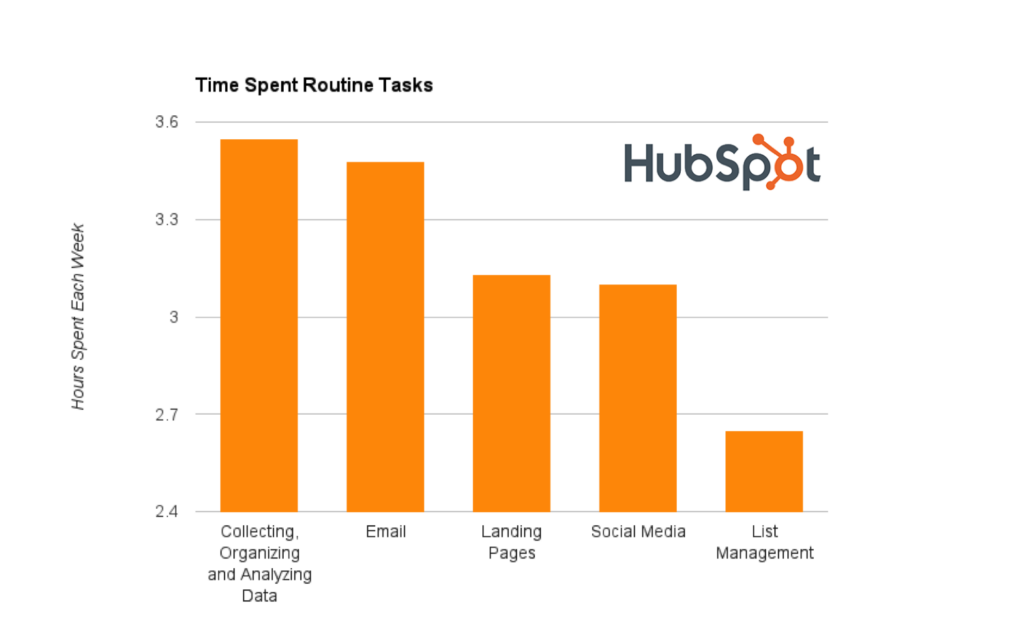
WIP limits are designed to limit the impact of this task-juggling on marketing projects by ensuring that team members don’t get distracted and instead finish the task they’re working on before starting a new one.
Minimum Viable Product
Minimum Viable Product (MVP) refers to the product that gives teams the most “validated learning” for the least effort.
An MVP is essentially a learning tool. It’s designed to help you gain insights into how your customers actually interact with your product or service faster. You can then apply those insights to the next sprint and deliver a better product.
How does this apply to marketing?
Let’s say you want to target a new segment of customers.
With traditional marketing methods, you might spend weeks or even months putting together a campaign, only to get a lukewarm reception. Plus you don’t have much more information about your audience than when you started.
If you‘re an Agile marketing team, you could run the leanest possible campaign, targeting a small number within this segment. You’d learn more, faster, and have more resources and time for further experimentation.
Sprint review or Retrospective
At the end of a sprint or a work cycle, the team meets together for a retrospective. The purpose of the meeting is to go over what worked and what didn’t about your Agile approach.
Retrospectives are judgment-free and data-driven. Remember that the overall goal is to provide constructive feedback and to improve efficiency in the next iteration.
This means not just looking at key metrics for the project itself and how it performed, but how you actually worked as a team.
The following questions can uncover ways to improve your next sprint:
- How long did each task take to complete?
You don’t have to rely on just self-reflection here: time tracking tools can gather this data for you effortlessly as you work on your project. Use this to inform your forecasting.
- Did the WIP limits work? Did you set your limits too high or too low?
Reflect on the roadblocks your team experienced and how can you anticipate them in the future.
- Are there any tasks left outstanding? Why?
Set a deadline for when they will be completed and discuss solutions to avoid this happening in the future.
What PM features do Agile marketers need?
Sprint roadmap planning
With most Agile marketing projects, you need a high-level roadmap of what activities will happen in each sprint.
Such a sprint roadmap gives the project’s stakeholders an overview of how a project will get delivered over a series of sprints. This way clients, managers, and team members get tentative visibility of the project’s timeline.
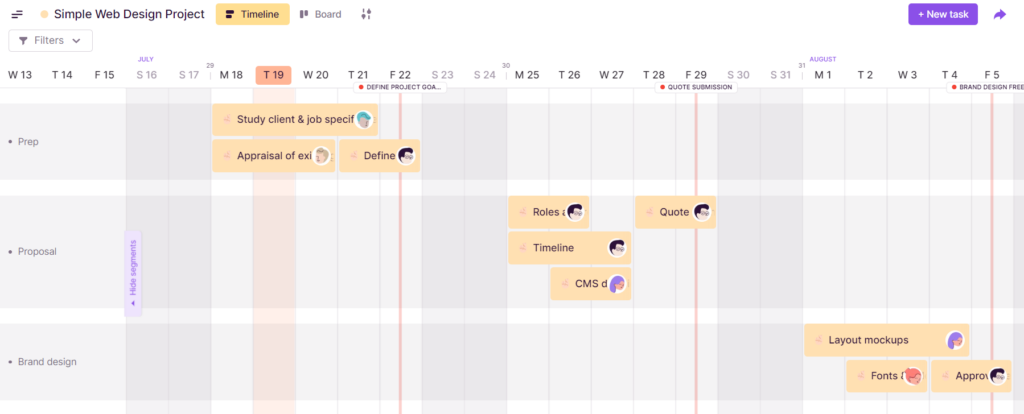
With Toggl Plan, you can plan multiple sprints on a single screen using Plan segments. The drag-and-drop timeline makes it easy to move tasks from one sprint to another. In addition, the timeline gives you visibility into critical milestones during a project’s timeline.
Kanban boards
As we mentioned earlier, a Kanban board helps visualize project and task progress.
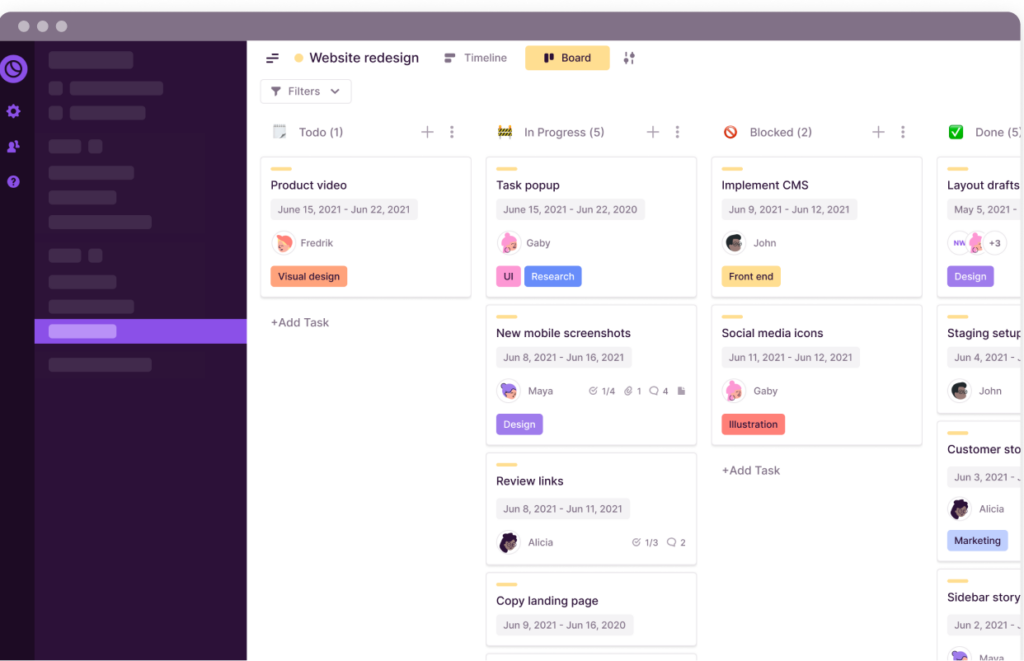
Typically laid out in a series of columns, each made up of separate task cards, Kanban boards show you at a glance:
- Which tasks need to be done by the end of the sprint?
- Who is working on them?
- What status they’re in?
- How long is the backlog?
- How close is the project to completion?
This is a perfect overview not cluttered with needless information. At the same time, it enables you to focus on what’s important.
Team workloads
Marketing and creative team members often work on multiple projects at a time.
For projects with strict deadlines, it’s critical to get your scheduling right. This prevents scheduling conflicts, missed deadlines, and burnt-out team members.
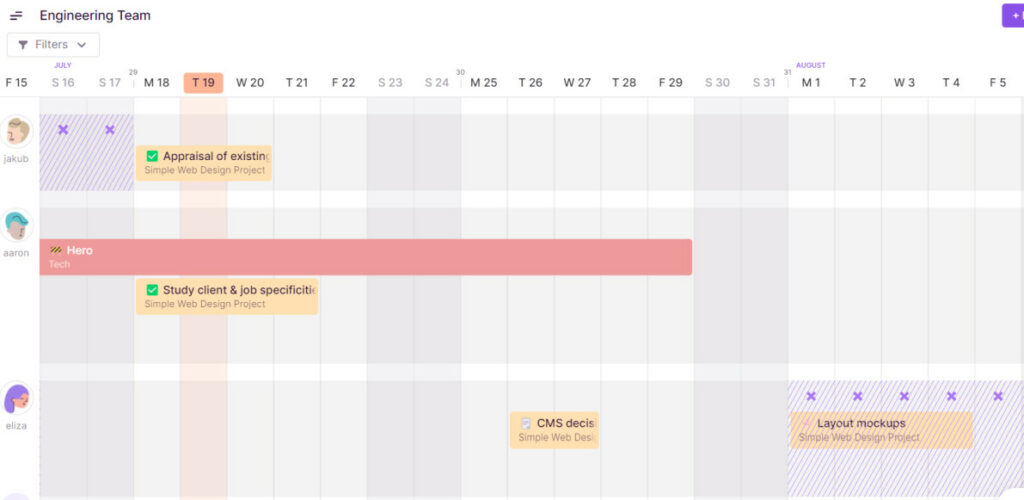
Being able to see at a glance what the members of your team are working on throughout the sprint is essential. This helps adjust schedules and rebalance workloads when necessary.
Conclusion
Agile marketing is a practical approach to the complexities of modern marketing. It provides teams with a way to manage and meet audience expectations.
As a marketing team there are many choices to make: increments vs. iterations, Kanban vs. Scrum, dedicated vs. shared resources, and more. Hopefully, this article helps you make these decisions.
